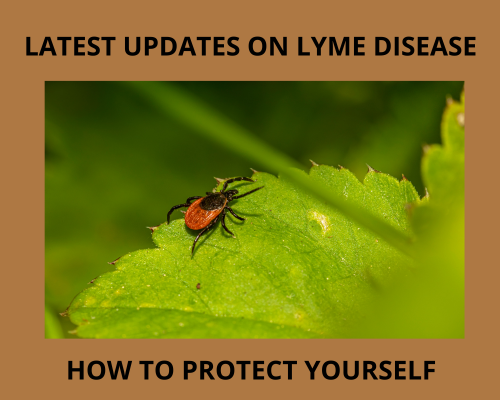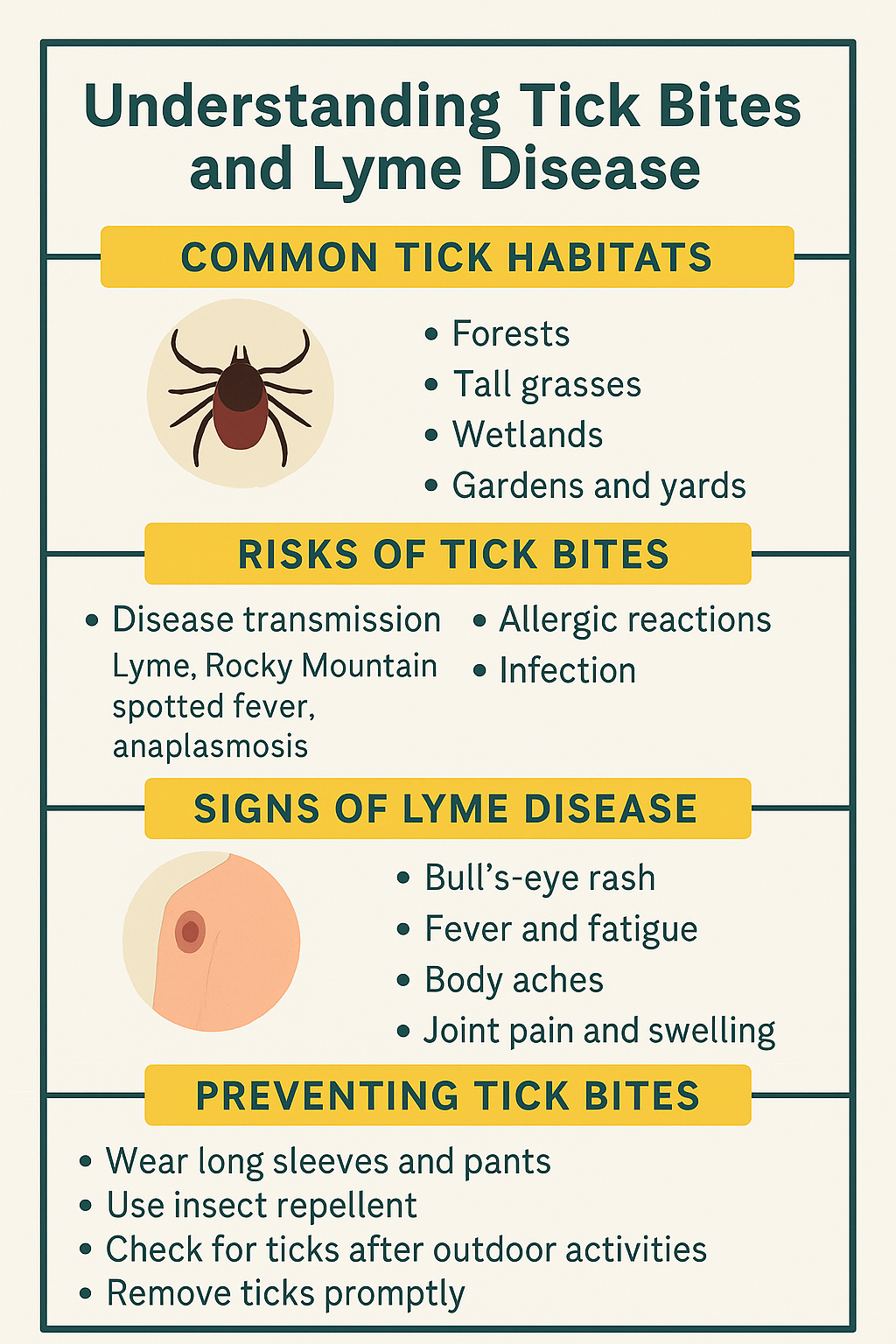Tick Bites & Lyme Disease: Symptoms, Prevention, and Treatment You Can’t Afford to Ignore
Wondering how to handle tick bites or prevent Lyme disease naturally? This comprehensive guide breaks down everything you need to know—from how ticks spread infection to how Traditional Chinese Medicine (TCM) can support recovery. Learn tick-removal techniques, Lyme symptoms, and the best herbal remedies backed by science.
Lyme disease isn’t just a seasonal nuisance—it’s an escalating public health concern that’s leaving many confused, misdiagnosed, and chronically unwell. Each year, over 476,000 people in the U.S. are diagnosed with Lyme, often after a seemingly innocent walk through tall grass or a tick hitching a ride home on a pet. But what happens after the bite? What symptoms should you watch for—and how can you heal if conventional treatments fall short?
In this definitive guide, we cover it all:
-
How to safely remove ticks and reduce infection risk
-
What early and late-stage Lyme disease symptoms look like
-
Medical treatments and evidence-based Chinese herbal alternatives
-
How to separate myth from fact in Lyme prevention
-
Practical, research-backed tools you can use today
Whether you’re hiking the Pacific Northwest or just walking your dog in suburbia, tick education could be the difference between health and long-term complications. This isn’t just about fear—it’s about powerful prevention and full-body support, including ancient herbal strategies that Western medicine is only beginning to appreciate.
Quick Summary: What to Know About Tick Bites & Lyme Disease
-
Ticks can transmit Lyme disease and other serious infections.
-
Risk increases in grassy, wooded, and damp outdoor areas.
-
Lyme disease symptoms include rash, fatigue, fever, and joint pain.
-
Black-legged (deer) ticks must remain attached 24+ hours to transmit Borrelia bacteria.
-
Early tick removal and prompt treatment drastically reduce risk of long-term illness.
What Are Ticks and Where Are They Found?
Ticks are tiny arachnids (related to spiders) known for feeding on the blood of mammals, birds, and reptiles. You’ll find them in shaded, humid, grassy, or wooded areas where they lie in wait for a host to brush past.
Common Tick Habitats:
-
Forest floors and leaf litter
-
Tall grasses and brush
-
Wetlands and creek beds
-
Dog parks and hiking trails
-
Gardens and yards near wooded areas
Even your own backyard can harbor ticks, especially if you live near wooded or overgrown areas.
Why Tick Bites Are a Big Deal
Tick bites can go unnoticed for hours—or even days. But during this time, the tick may transmit dangerous bacteria like Borrelia burgdorferi, the cause of Lyme disease. Other pathogens include:
-
Anaplasma phagocytophilum (anaplasmosis)
-
Rickettsia rickettsii (Rocky Mountain spotted fever)
-
Ehrlichia species
Ticks also inject saliva that can cause allergic reactions, rashes, and skin infections if not removed properly.
Lyme Disease: The Silent Stalker
What Is Lyme Disease?
Lyme disease is a bacterial infection transmitted primarily through the bite of an infected black-legged tick (Ixodes scapularis). It was first identified in Lyme, Connecticut in the 1970s and has since spread across the U.S., particularly in the Northeast, Upper Midwest, and Pacific Coast.
Early Symptoms (3–30 Days Post-Bite)
-
Red rash (often bull’s-eye shaped, aka erythema migrans)
-
Flu-like symptoms: fatigue, fever, chills, headache
-
Swollen lymph nodes, muscle aches
Later Stage Symptoms (Weeks to Months After)
-
Joint pain, especially in knees
-
Facial paralysis (Bell’s palsy)
-
Numbness or tingling
-
Memory problems
-
Heart palpitations or arrhythmias
Not everyone gets the rash. Some people never notice symptoms until serious complications develop.
Lyme Diagnosis & Testing
-
Doctors consider symptoms, tick exposure, and geography
-
Early blood tests can yield false negatives
-
Antibody tests are more accurate weeks after exposure
How Lyme Disease Spreads
Step-by-Step Infection Process:
-
Attachment: Tick latches onto skin in hidden places like the scalp, groin, or behind knees.
-
Feeding: Over 24–36 hours, tick injects bacteria while feeding.
-
Transmission: Borrelia bacteria enter bloodstream.
Removing the tick within 24 hours dramatically reduces the chance of Lyme disease.
Who's at Risk?
Increased Risk Factors:
-
Living in Lyme-endemic regions (NE, Midwest, NW U.S.)
-
Outdoor activities: hiking, camping, gardening
-
Pets that roam outdoors
-
Wearing shorts or sandals in high-risk zones
-
Spring through early fall exposure
Tick Lifecycle & Timing
Ticks go through four stages: egg, larva, nymph, adult. Nymphs are the most dangerous stage—they're tiny (poppy-seed sized) and most likely to transmit Lyme in late spring and early summer.
Tick Activity by Season
| Season | Tick Stage | Risk Level |
|---|---|---|
| Spring | Nymph | High |
| Summer | Nymph/Adult | Very High |
| Fall | Adult | Moderate |
| Winter | Dormant | Low |
How to Prevent Tick Bites
-
Wear light-colored, long-sleeved clothing
-
Use insect repellent or oil of lemon eucalyptus
-
Treat clothing and gear with permethrin
-
Stick to trails; avoid tall grass and dense brush
-
Do daily tick checks on yourself, kids, and pets
-
Shower within 2 hours of outdoor activity
Yard Protection
-
Keep grass trimmed
-
Remove leaf litter
-
Create a barrier between woods and yard (wood chips or gravel)
-
Keep woodpiles dry and neat
Proper Tick Removal
-
Use fine-tipped tweezers.
-
Grasp tick close to the skin’s surface.
-
Pull upward steadily. Don’t twist.
-
Disinfect skin with alcohol or iodine.
-
Save the tick in a sealed bag for ID or testing.
-
Watch for symptoms.
Treatment Options for Lyme Disease
When it comes to Lyme disease, timing is everything. Early intervention with the right combination of medical and holistic treatments can significantly improve outcomes. Below are updated treatment strategies, blending Western medicine with Traditional Chinese Medicine (TCM) for a comprehensive approach.
✅ Early Stage Lyme Disease
Western Medicine
-
Antibiotics:
-
Doxycycline, Amoxicillin, or Cefuroxime
-
-
Duration:
-
10–21 days, depending on age, symptoms, and tick exposure timeline
-
-
Outlook:
-
Most patients experience symptom relief and resolution within 3–4 weeks
-
Chinese Herbal Support (Use with guidance from a licensed practitioner)
-
Andrographis (Chuan Xin Lian):
-
Known for clearing heat and toxicity, supports immune response to bacterial invasion
-
-
Houttuynia (Yu Xing Cao):
-
Antimicrobial, lung-supportive, used in early infection and inflammation
-
-
Isatis Root (Ban Lan Gen):
-
Commonly used in China to help reduce fever, sore throat, and systemic toxicity
-
-
Scutellaria (Huang Qin):
-
Helps clear damp-heat and supports liver detoxification
-
Advanced or Persistent Lyme Disease
Western Medicine
-
IV Antibiotics:
-
Ceftriaxone or similar, often used in late-stage cases with neurological or cardiac involvement
-
-
Supportive Therapies:
-
Physical therapy for joint pain and stiffness
-
Anti-inflammatory medications as needed
-
Chinese Herbal Integration (often used alongside conventional care)
-
Stephania Root (Han Fang Ji or Fang Ji):
-
Historically used for joint swelling and pain, especially in post-Lyme arthritis
-
-
Sarsaparilla Root (Tu Fu Ling):
-
Traditionally used for toxin clearance and chronic skin or joint conditions
-
-
Cordyceps (Dong Chong Xia Cao):
-
Adaptogen that restores Qi and supports kidney and lung health after long illness
-
-
Astragalus (Huang Qi):
-
Rebuilds Wei Qi (defensive energy), used after the active infection has passed
-
Holistic Recovery Tips
Even after treatment, some patients may experience lingering symptoms. This is where lifestyle and Chinese medicine shine:
-
Nutrition:
-
Emphasize anti-inflammatory, nutrient-rich foods
-
-
Sleep:
-
Prioritize restorative rest to support neurological recovery
-
-
TCM Tonics:
-
Rehmannia (Shu Di Huang), Dang Shen, and Bai Zhu may be used in rebuilding Qi and Blood after prolonged illness
-
Common Myths (and Truths)
| Myth | Truth |
| Only woods have ticks | Yards, parks, even beaches can harbor ticks |
| You’ll always see the tick | Nymphs are tiny—many bites go unnoticed |
| Lyme is always cured with one antibiotic round | Some need extended care for chronic symptoms |
| Ticks die in winter | Some stay active above freezing temps |
Final Thoughts
Ticks may be small, but the consequences of their bites can be massive. Prevention, awareness, and quick action are your best defenses against Lyme disease and other tick-borne illnesses.
✅ Take action now: Stock your first aid kit, treat your clothes and yard, and learn how to safely enjoy nature.
Ready to protect your family from ticks the natural way? Explore herbal tick repellents, immune-boosting herbs, and natural first-aid at 1stChineseHerbs.com
Related Resources:
-
Andrographis (Chuan Xin Lian)
Recommended during early-stage Lyme to combat bacterial infection and support immune function.
-
“Andrographis paniculata has antibacterial, antiviral, and immunomodulatory properties and is widely used in Lyme disease treatment” lelaniloubser.com+2lymeherbs.eu+2pubmed.ncbi.nlm.nih.gov+2casi.org+6lymedisease.org+6lymeherbs.eu+6.
-
Known to disrupt bacterial biofilms and inhibit inflammatory cytokines (IL‑1β, IL‑6) casi.org.
✅ 2. Cordyceps (Dong Chong Xia Cao)
Used in later-stage Lyme protocols to rebuild immunity after antibiotics.
-
A 2024 randomized controlled trial confirmed Cordyceps militaris enhances immune response in healthy adults lymedisease.org+12shop.navacenter.com+12pubmed.ncbi.nlm.nih.gov+12en.wikipedia.org+2pubmed.ncbi.nlm.nih.gov+2verywellhealth.com+2.
-
A 2021 review highlighted Cordyceps’ immune‑stimulatory, antioxidant, and anti‑inflammatory effects via cytokine modulation (IL‑1β, IL‑2, IL‑6, TNF‑α) pmc.ncbi.nlm.nih.gov+1pubmed.ncbi.nlm.nih.gov+1.
✅ 3. Stephania & Sarsaparilla
Both are classic TCM herbs for post-infectious joint pain and toxin clearance:
-
Stephania herbal blends are traditionally used for joint swelling and pain relief in rheumatic conditions medicalnewstoday.com+6projectlyme.org+6lymedisease.org+6.
-
Sarsaparilla (Tu Fu Ling) supports toxin removal in chronic skin and joint cases, commonly included in Lyme protocols lymedisease.org.
✅ 4. Immune Modulators: Reishi & Astragalus
Used to stabilize immunity post-infection and support recovery from Post-Treatment Lyme Disease Syndrome (PTLDS).
-
Cordyceps and Reishi are classified as immunomodulators, enhancing immune resilience while reducing inflammation verywellhealth.com+2pmc.ncbi.nlm.nih.gov+2en.wikipedia.org+2lymedisease.org+2lymedisease.org+2.
-


